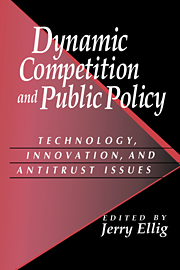Book contents
- Frontmatter
- Contents
- List of Figures and Tables
- Acknowledgments
- List of Contributors
- Introduction
- 1 A Taxonomy of Dynamic Competition Theories
- 2 Competence Explanations of Economic Profits in Strategic Management: Some Policy Implications
- 3 Innovation and Antitrust Enforcement
- 4 New Indicia for Antitrust Analysis in Markets Experiencing Rapid Innovation
- 5 Innovation and Monopoly Leveraging
- 6 Network Effects and the Microsoft Case
- 7 Technological Standards, Innovation, and Essential Facilities: Toward a Schumpeterian Post-Chicago Approach
- 8 Intellectual Property and Antitrust Limitations on Contract
- 9 Conclusion
- Index
8 - Intellectual Property and Antitrust Limitations on Contract
Published online by Cambridge University Press: 05 June 2012
- Frontmatter
- Contents
- List of Figures and Tables
- Acknowledgments
- List of Contributors
- Introduction
- 1 A Taxonomy of Dynamic Competition Theories
- 2 Competence Explanations of Economic Profits in Strategic Management: Some Policy Implications
- 3 Innovation and Antitrust Enforcement
- 4 New Indicia for Antitrust Analysis in Markets Experiencing Rapid Innovation
- 5 Innovation and Monopoly Leveraging
- 6 Network Effects and the Microsoft Case
- 7 Technological Standards, Innovation, and Essential Facilities: Toward a Schumpeterian Post-Chicago Approach
- 8 Intellectual Property and Antitrust Limitations on Contract
- 9 Conclusion
- Index
Summary
The existence of a tradeoff between the use of ideas and the incentives for their creation is both a central and recurring theme in the legal and economic analysis of intellectual property rights. It is the primary issue in legal and economic analyses that attempt to define the proper scope of legal protection for intellectual property (Arrow 1962; Easterbrook 1982).
This inquiry is not limited to the scope of property rights contained in federal or state statutory or common law. An integral part of the inquiry into the proper scope of intellectual property laws is how related contracts affect the use-creation tradeoff. Contracts based on use of intellectual property rights are an indispensable complement to intellectual property (Nimmer 1998; Kobayashi and Ribstein 1999; Ginsburg 1997). However, the scope of contracting over intellectual property rights is limited by law in important ways.
First, the intellectual property laws impose limits on contracts. Contracts can be held unenforceable because they are preempted by the federal intellectual property laws. The primary inquiry is one of use versus creation, with preemption resulting if the contract upsets the system of “uniform federal standards” that are “carefully used to promote invention while at the same time preserving free competition.” Second, provisions of the copyright law, such as the first-sale and fair-use doctrines, directly limit copyright holders' ability to control use of their works.
- Type
- Chapter
- Information
- Dynamic Competition and Public PolicyTechnology, Innovation, and Antitrust Issues, pp. 229 - 263Publisher: Cambridge University PressPrint publication year: 2001
- 1
- Cited by



